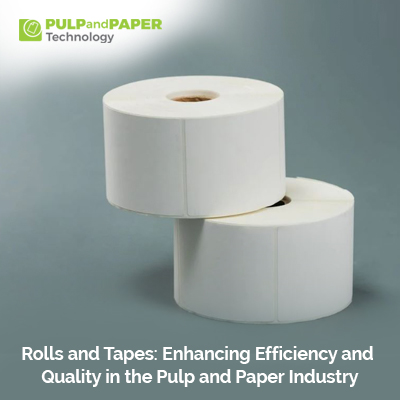Rolls and Tapes: Enhancing Efficiency and Quality in the Pulp and Paper Industry

Introduction
The pulp and paper industry plays a vital role in the global economy, providing essential materials for various products, from newspapers to packaging materials. As technology continues to evolve, the industry faces the constant challenge of improving efficiency and maintaining high-quality standards. One area where significant advancements have been made is in the use of rolls and tapes. These seemingly simple components are crucial for enhancing efficiency and ensuring the quality of the production process in the pulp and paper industry.
I. The Role of Rolls in the Pulp and Paper Industry
Rolls are fundamental components in the pulp and paper manufacturing process, serving multiple purposes that contribute to the overall efficiency and quality of production. These cylindrical structures are used in various stages of the papermaking process, from pulp preparation to the final printing or packaging phase.
Pulp Preparation
In the initial stages of paper production, rolls are utilized in pulp preparation. Pulp, a mixture of fibers, water, and chemicals, undergoes a series of processes to transform into paper. Rolls are employed to squeeze water out of the pulp, forming a continuous sheet that can be further processed.
Press Section
In the press section, rolls play a critical role in removing excess water from the paper sheet. This process, known as dewatering, is essential for achieving the desired paper thickness and quality. Well-designed rolls ensure uniform pressure distribution, preventing uneven drying and reducing the likelihood of defects in the final product.
| Also Read: How Rolls, Tapes, and More Innovate the Pulp And Paper Industry? |
Drying Section
Rolls are also employed in the drying section, where the paper sheet passes through heated cylinders to remove the remaining moisture. Efficient drying is crucial for maintaining the paper's physical properties and preventing issues such as wrinkling or uneven coating.
Calendering
After drying, the paper may undergo calendering, a process that involves passing it through rolls to improve its smoothness, gloss, and overall appearance. This enhances the paper's printability and surface quality, contributing to the final product's market value.
II. The Significance of Tapes in Paper Manufacturing
While rolls are essential components, tapes are equally critical for ensuring the efficiency and quality of the pulp and paper manufacturing process. Tapes play a diverse range of roles, from joining materials to facilitating the movement of paper through various stages of production.
Splicing Tapes
Splicing tapes are commonly used in the paper industry to join the end of one roll to the beginning of another seamlessly. This ensures a continuous production process, minimizing downtime and waste. Splicing tapes contributes to operational efficiency by allowing machines to run continuously without the need for manual intervention during roll changes.
Repulpable Tapes
As sustainability becomes increasingly important, repulpable tapes have gained popularity in the pulp and paper industry. Unlike traditional tapes that can contaminate the recycling process, repulpable tapes dissolve during the repulping stage, allowing for cleaner and more efficient recycling of paper products.
Traction Tapes
Traction tapes are used to improve the grip between rolls and the paper sheet, preventing slippage during various stages of the manufacturing process. This ensures the accurate and consistent movement of the paper, reducing the likelihood of defects and improving overall quality.
Edge Reinforcement Tapes
During winding and slitting processes, edge reinforcement tapes are applied to prevent edge damage and ensure the integrity of the paper rolls. These tapes enhance the strength and stability of the paper, reducing the risk of tears or damage during handling and transportation.
III. Enhancing Efficiency with Advanced Roll and Tape Technologies
Advancements in technology have led to the development of specialized rolls and tapes that further enhance efficiency and quality in the pulp and paper industry.
Advanced Roll Coatings
Innovative coatings applied to rolls can significantly improve their performance. For example, ceramic coatings can enhance wear resistance, reducing the frequency of roll replacements and minimizing downtime. Non-stick coatings can also be applied to prevent the build-up of materials on rolls, improving overall efficiency and reducing maintenance requirements.
Smart Rolls
The integration of smart technologies into rolls is another noteworthy development. Smart rolls are equipped with sensors and monitoring systems that provide real-time data on various parameters, such as temperature, pressure, and wear. This allows for predictive maintenance, enabling proactive measures to be taken before issues arise, thereby minimizing downtime and optimizing production efficiency.
High-performance Tapes
The development of high-performance tapes with advanced adhesive properties has revolutionized the industry. These tapes offer superior bonding strength, ensuring reliable splicing and minimizing the risk of tape-related defects. Additionally, tapes with enhanced heat resistance and durability contribute to more stable and efficient production processes.
IV. Quality Assurance through Rolls and Tapes
Ensuring the quality of paper products is paramount in the pulp and paper industry, as even minor defects can impact the functionality and marketability of the final product. Rolls and tapes play a crucial role in maintaining and enhancing product quality through several key mechanisms.
Uniform Pressure Distribution
Well-designed rolls contribute to uniform pressure distribution during the pressing and drying stages. This prevents uneven moisture levels in the paper, reducing the likelihood of defects such as cockling or warping. Uniform pressure also ensures consistent paper thickness, contributing to the overall quality of the final product.
Precise Coating and Calendering
Rolls used in coating and calendering processes are instrumental in achieving precise and consistent results. The controlled application of coatings and the smooth calendering of paper contribute to improved printability, surface finish, and overall aesthetic appeal.
Reliable Splicing
The use of high-quality splicing tapes is critical for maintaining the integrity of the paper rolls. Reliable splicing ensures a continuous production process, reducing the occurrence of defects caused by manual interventions during roll changes. This contributes to the overall efficiency and quality of the manufacturing process.
Clean and Repulpable Solutions
The adoption of clean and repulpable tape solutions aligns with the industry's growing emphasis on sustainability. These tapes contribute to cleaner recycling processes, ensuring that recycled paper maintains its quality and can be used in the production of high-quality products.
V. Conclusion:
Rolls and tapes may seem like simple components in the complex world of pulp and paper manufacturing, but their significance cannot be overstated. From the efficient movement of paper through various stages to the enhancement of product quality, rolls and tapes play integral roles in shaping the industry's success. As technology continues to advance, the ongoing development of smart rolls, high-performance tapes, and other innovative solutions will undoubtedly contribute to further improvements in efficiency and quality within the pulp and paper sector. Embracing these advancements will not only benefit manufacturers but also contribute to the sustainability and competitiveness of the entire industry on a global scale.









